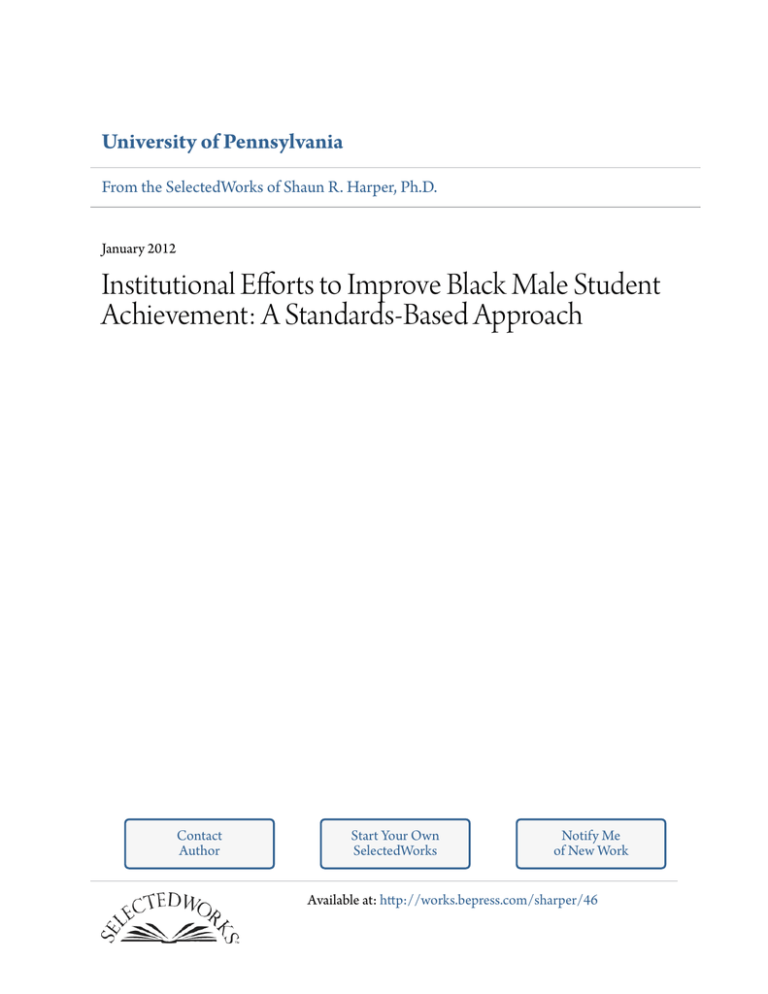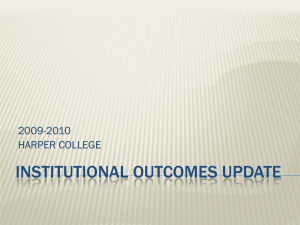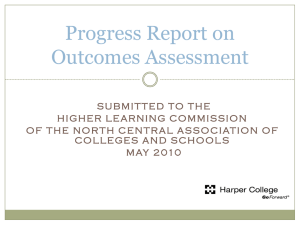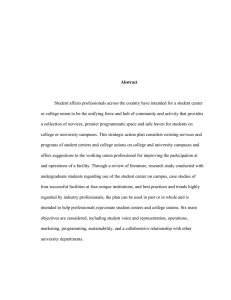Institutional Efforts to Improve Black Male Student Achievement: A
advertisement

University of Pennsylvania From the SelectedWorks of Shaun R. Harper, Ph.D. January 2012 Institutional Efforts to Improve Black Male Student Achievement: A Standards-Based Approach Contact Author Start Your Own SelectedWorks Notify Me of New Work Available at: http://works.bepress.com/sharper/46 INSTITUTIONAL EFFORTS TO IMPROVE BLACK MALE STUDENT ACHIEVEMENT: Downloaded by [University of Pennsylvania], [Shaun R. Harper] at 08:36 26 March 2012 By Shaun R. Harper and John A. Kuykendall A Standards-Based APPROACH A ccording to a 2010 report from the Schott Foundation for Public Education, only 47 percent of black male students graduated from high school in 2008 with peers in their entering cohorts. Thus, much emphasis has been placed on improving these students’ high school graduation rates and increasing the number of them who pursue some form of postsecondary education. But success in getting more of these men out of high school and into college could be pointless if we do not also ensure that they transition smoothly from high school and then, once in college, learn much, accrue important developmental gains, benefit from institutional resources, and ultimately persist through baccalaureate degree attainment. Unfortunately, though, many of the problems that plague these students in K–12 schools also follow them into higher education. Black men’s troubled status in higher education has garnered tremendous attention at national conferences, in the media, and in published scholarship over the past 15 years. As researchers make the complexities of the problem increasingly clear, educators, administrators, and policymakers alike have grappled with the question of what must be done to improve black male student success. Researchers have found, for example, that black undergraduate men are less prepared for the rigors of collegelevel work compared to their peers from other racial groups (Bonner & Bailey, 2006; Palmer, Davis, & Hilton, 2009). They also tend to be less engaged than others in college classrooms, clubs and structured campus activities, and enriching educational experiences outside the classroom www.changemag.org (Cuyjet, 1997; Harper, Carini, Bridges, & Hayek, 2004). Consequently, black women far surpass their same-race male counterparts in postsecondary degree attainment at every level (see Table 1). TABLE 1 BLACK STUDENTS’ POSTSECONDARY DEGREE ATTAINMENT BY LEVEL AND SEX, 2009 Men Percent Women Percent Associate’s 31.5 68.5 Bachelor’s 34.1 65.9 Master’s 28.2 71.8 First Professional1 38.0 62.0 Doctoral 33.5 66.5 2 Source: U.S. Department of Education (2010) 1 2 For example, J.D., M.D., and D.D.S. degrees Only Ph.D., Ed.D., and academic doctorates Shaun R. Harper (sharper1@upenn.edu) is on the faculty in the Graduate School of Education, Africana Studies, and Gender Studies at the University of Pennsylvania, where he also serves as director of the Center for the Study of Race and Equity in Education. John A. Kuykendall (jakuykendall@ualr.edu) is an assistant professor of higher education at the University of Arkansas at Little Rock 23 Underpreparedness and disengagement are often identified as factors that help explain high college-dropout rates. And indeed, as shown in Table 2, across four cohorts of undergraduates attending institutions in the California State University system, on average only 27.7 percent of black men graduated within six years, as compared to 46.7 percent of students overall—a 19 percentage point gap. On the University of California campuses, the graduation gap was 14.3 percent—65.6 percent for black undergraduate men and 79.9 percent for students overall. Like the graduation rates at public universities in California, statistics at other postsecondary institutions consistently show differential outcomes by race and gender across a range of educational outcomes, and in many domains, black undergraduate men are the most disadvantaged. Nationally, less than one-third of them earn bachelor’s degrees within six years, which is the lowest college-completion rate among both sexes and all racial groups in US higher education (Harper, 2012). Downloaded by [University of Pennsylvania], [Shaun R. Harper] at 08:36 26 March 2012 TABLE 2 SIX-YEAR GRADUATION RATES AT PUBLIC UNIVERSITIES IN CALIFORNIA, 2006–2009 Black Men Percent Students Overall Percent Percent Difference California Polytechnic State University, San Luis Obispo 49 69 –19 California State Polytechnic University, Pomona 31 50 –19 California State University, Bakersfield 14 41 –27 California State University, Chico 24 55 –31 California State University, Dominguez Hills 21 32 –11 California State University, East Bay 29 44 –14 California State University, Fresno 20 47 –27 California State University, Fullerton 32 50 –18 California State University, Long Beach 34 51 –17 California State University, Los Angeles 19 33 –13 California State University, Northridge 22 41 –19 California State University, Sacramento 22 42 –21 California State University, San Bernardino 28 43 –15 California State University, San Marcos 31 43 –12 California State University, Stanislaus 23 51 –28 Humboldt State University 20 42 –22 San Diego State University 50 61 –11 San Francisco State University 25 44 –19 San Jose State University 23 43 –19 Sonoma State University 36 52 –16 University of California, Berkeley 62 89 –27 University of California, Davis 65 80 –15 University of California, Irvine 65 80 –15 University of California, Los Angeles 66 89 –24 University of California, Riverside 58 65 –6 University of California, San Diego 70 85 –15 University of California, Santa Barbara 73 80 –7 University of California, Santa Cruz 66 71 –5 Institution Excludes California State University-Channel Islands and University of California-Merced, institutions for which four complete years of cohort data were unavailable. 24 #HANGE s -ARCH!PRIL Downloaded by [University of Pennsylvania], [Shaun R. Harper] at 08:36 26 March 2012 With emotions that range from sympathetic concern to widespread panic, professionals on college and university campuses have employed a number of strategies in response to these problems. Typical approaches include matching black undergraduate men with faculty and staff mentors, starting an organization specifically for them, and offering them a variety of social activities. Astonishingly popular are one-time, day-long black male summits that bring high-profile keynote speakers to campus. But rarely are senior-level administrators or white faculty members present, and oftentimes these events are not connected to a larger set of strategic efforts. Usually, professionals from the black culture center or multicultural affairs division are largely (if not singlehandedly) responsible for these and other attempts to better support, engage, retain, and graduate black male collegians. We argue in this article that such approaches are insufficient; in most instances, only marginal measurable gains have been produced. Many educators and administrators who endeavor to improve outcomes for black male students may unintentionally do their work in ways that sustain inequity— for example, by offering compensatory programs that focus entirely on fixing the student as opposed to transforming the institution and exposing environmental toxins that persistently undermine his success. This is partially attributable to the absence of standards to guide institutional activities, measure institutional commitment, and systematically assess institutional effectiveness. The latter portion of Michael J. Cuyjet’s (2006) groundbreaking book, African American Men in College, features nine exemplary programs and initiatives that showed promising results in improving black male student engagement and achievement. These models are thoughtful and inspirational. Notwithstanding, replication is unlikely to achieve the exact same results everywhere. For instance, although the campuses are only a few miles apart, what worked well for Arizona State University (a fouryear institution highlighted in the book) may be ineffective at the ten Maricopa Community College campuses in the Professionals on campus create initiatives to improve black male student success without a full understanding of how pervasive the challenge is or in which areas institutional action is most urgently needed. www.changemag.org Phoenix metropolitan area. Moreover, no single initiative on its own will be enough to eradicate all the academic, financial, social, and political forces that collectively undermine black male student achievement. A problem as complex as this demands a complex solution. As such, it seems necessary to have a published set of standards for initiatives that are designed to improve black male student success in college. Presented here are eight that we collaboratively developed for the 2010 convening of the Arkansas African American Male Initiative (AAMI), a statewide consortium of community colleges and four-year institutions. These standards are based in part on findings from the National Black Male College Achievement Study (see Harper, 2012), as well as on insights from our engagement with dozens of black male initiatives across the country. THE EIGHT STANDARDS 1. Inequities are transparent, and data are used to guide institutional activities. Data concerning racial disparities are usually so problematic that campus leaders and professionals in offices of institutional research often choose not to disclose them publicly. They fear that doing so would embarrass the institution and potentially dissuade future students of color from enrolling. Consequently, other professionals on campus create initiatives to improve black male student success without a full understanding of how pervasive the challenge is or in which areas institutional action is most urgently needed. The status of black undergraduate men must be publicly disclosed. Widely disseminated annual status reports, for example, would help raise institutional consciousness. More informed choices could then be made about the investment of institutional resources. An excellent model is the Equity Scorecard process, which has been used by the University of Wisconsin System, the Pennsylvania State System of Higher Education, dozens of California community colleges, and numerous other campuses across the country. The process brings together teams of faculty, administrators, and institutional researchers to examine and make sense of data that have been disaggregated by race and gender (see Harris, Bensimon, & Bishop, 2010). Examining data in this way usually compels team members to look for explanations, think about how their own individual practices might undermine equity, and determine what the institution must do to close racial and gender gaps in student achievement. 2. Black undergraduate men are meaningfully engaged as collaborators and viewed as experts in designing, implementing, and assessing campus initiatives. Well-intentioned professionals sometimes create black male initiatives without much input from undergraduates. For instance, in addition to a keynote speaker, the 25 If sustainable institutional progress is to be made, the chief diversity officer cannot be the only person who has a plan for improving the status Downloaded by [University of Pennsylvania], [Shaun R. Harper] at 08:36 26 March 2012 of black male students. aforementioned black male summits hosted on college campuses also commonly include workshops presented by “experts.” Rarely are students among the presenters. In other instances, the onus is placed entirely on students to do all the planning, fundraising, and marketing. Best is when black male undergraduates are engaged as equally powerful collaborators with administrators and the expertise these men possess regarding their individual and collective experiences on campus is highly valued. Some version of this already occurs on many campuses, but usually the only black men invited to participate are well-known student leaders. Lower-performing undergraduates also should be actively sought, as this opportunity could be a turning point in their college trajectories. Plus, they are likely to know much about what the majority of their same-race male peers need, experience, and would find appealing. 3. Actions are guided by a written strategy document that is collaboratively developed by various institutional stakeholders, ranging from undergraduate students to the college president. On many campuses, programs and activities aimed at improving black male student achievement are unconnected to comprehensive written plans that include well-defined goals, anticipated outcomes, details concerning crosscampus collaboration and coordination, and assessment strategies. If sustainable institutional progress is to be made, the chief diversity officer cannot be the only person who has a plan for improving the status of black male students. Administrators and faculty at all levels (including the president, provost, and tenured white professors) and black undergraduate men must work together in fashioning a document in which strategies for addressing insti26 tutional barriers that impede student achievement are outlined. The document should clearly convey that the institution, not just its black culture center or employees of color, assumes responsibility for employing a coordinated set of strategies to improve black male student success. 4. Learning, academic achievement, student development, and improved degree attainment rates are prioritized over social programming. Some campus initiatives focus almost entirely on providing entertainment and opportunities for social interaction among black students. While they produce few academic outcomes, social support activities are undoubtedly critical on campuses at which black undergraduates are severely underrepresented. If properly structured, they can also improve students’ communication skills. However, architects of the strategy document and subsequent initiatives should prioritize programs and services that will help black male students adjust smoothly to the academic demands of college, learn how to effectively study and manage their time, resolve identity conflicts that undermine academic achievement, respond productively to racist stereotypes, and learn how to ask for help well before they find themselves on the brink of failing a course or—even worse—dropping out. The plan and the initiatives that emerge from it should also include an emphasis on increasing black male student engagement in enriching educational experiences that are known to provide powerful opportunities for learning and personal growth (e.g., study-abroad programs, faculty-supervised undergraduate research experiences, service learning, and summer internships in their fields). 5. Initiatives are grounded in published research on college men and masculinities in general and on black male undergraduates in particular. Programs, activities, and institutional efforts to improve black male student success are sometimes creative but often based on no empirical research. In addition to relying on data collected by the institution, architects of these programs should make good use of the books, journal articles, and reports that have been published on this topic over the past 15 years. Four important books are highlighted as recommended readings in this article. Other seminal works and research studies are cited in Black Male Student Success in Higher Education: A Report from the National Black Male College Achievement Study (Harper 2012). Additionally, a comprehensive bibliography of recent scholarship on black male undergraduates is available at www.works. bepress.com/sharper/45. #HANGE s -ARCH!PRIL Downloaded by [University of Pennsylvania], [Shaun R. Harper] at 08:36 26 March 2012 RECOMMENDED READINGS 6. Efforts are enhanced by insights from black male student achievers. Black male initiatives are typically created because some person or unit on campus recognizes racial and gender differences in academic performance, student engagement, resource utilization, and degree attainment rates. Emphasis is therefore placed on trying to understand why the majority of black undergraduate men perform so poorly in college. But Harper (2012) argues the following: “Those who are interested in Black male student success have much to learn from Black men who have actually been successful. To increase their educational attainment, the popular onesided emphasis on failure and low-performing Black male undergraduates must be counterbalanced with insights gathered from those who somehow manage to navigate their way to and through higher education, despite all that is stacked against them” (p. 1). There are black men who earn good grades and are actively engaged inside and outside the classroom; after all, approximately one-third of this population persists through baccalaureate degree attainment. Hence, institutional stakeholders should better understand the conditions and institutionalize the factors that enable current achievers to thrive and that helped black male alumni www.changemag.org to persist when they were enrolled. Unfortunately most students interviewed for the National Black Male College Achievement Study indicated that no institutional agent had previously pursued insights into their success. 7. Institutional agents engage in honest conversations about racism and its harmful effects on black male student outcomes. Racist stereotypes and encounters with other forms of racism on predominantly white campuses pose serious threats to black male student achievement. Initiatives that ignore these issues are likely to experience limited success. In their multi-institution study of campus racial climates, Harper and Hurtado (2007) found that faculty 27 and administrators deliberately avoided conversations regarding race, in large part because they were afraid of showing their racial naïveté or of being misperceived as racist. Downloaded by [University of Pennsylvania], [Shaun R. Harper] at 08:36 26 March 2012 Racial disparities cannot be fully understood or responsibly addressed on college and university campuses where such avoidance is commonplace. Acknowledging the existence of racism and racial stereotypes is a necessary first step in strategically addressing their harmful effects on black men’s educational outcomes and sense of belonging. 8. At every level, institutional agents are held accountable for improving black male student retention, academic success, engagement, and graduation rates. The trustees must hold the president accountable, the president must hold senior-level administrators accountable, deans and other institutional leaders must hold the units that report to them accountable, and individual educators must hold themselves accountable for doing all that is necessary to actualize every goal articulated in the institution’s strategic document concerning black male student success. Such accountability demands individual and collective reflection, the sharing of assessment data, evidence of educational effectiveness, and an appropriate remediation of professional practices that cyclically remanufacture inequity. The institution should offer structured developmental opportunities and resources for faculty and administrators who may not know how to effectively engage black undergraduate men or teach in ways that respond to their cultural needs. Furthermore, these educators should be challenged to confront the implicit biases that lead them to have low expectations for and racist stereotypes about these students. STANDARDS IMPLEMENTATION: INSTITUTIONAL EXAMPLES The Arkansas AAMI has adopted these standards, and member institutions are presently using them to govern and assess their activities (see Table 3 for a list of institutions). Annual reports to the Winthrop Rockefeller Foundation, the primary funder of the statewide consortium, include details of how stakeholders at each institution have used the standards to assess their campus initiatives. The University of Arkansas at Little Rock (UALR) began its initiative with a self-study and has made its findings transparent, invited public conversations about troubling inequities that persistently disadvantage black male students, constructed a strategy document, and involved a variety of stakeholders (including the chancellor, vice chancellor for student affairs, faculty, and students) in the implementation and assessment of its activities. Moreover, while much effort is devoted to improving UALR’s 7.9 percent six-year graduation rate for black male students, its initiative includes a simultaneous focus on identity and leadership development, as well as on improving students’ critical reasoning, communication, and problem-solving skills. In addition to the 17 institutions in Arkansas, five other campuses are using the standards in the design, implementation, and assessment of their black male initiatives: the Community College of Philadelphia, North Carolina Central University, Stanford University, UCLA, and the University of Wisconsin-Madison. These colleges and universities are participants in the Institutional Change for Black Male Student Success Project, which is funded by Lumina Foundation for Education and coordinated by the University of Pennsylvania’s Center for the Study of Race and Equity in Education. TABLE 3 ARKANSAS AAMI CONSORTIUM: PARTICIPATING INSTITUTIONS Community and Technical Colleges Four-Year Colleges and Universities Arbor Education and Training Arkansas Baptist College Arkansas Technical College Arkansas State University – Main Campus East Arkansas Community College Arkansas State University – Newport Mid-South Community College Henderson State University National Park Community College Philander Smith College Ouachita Technical College Southern Arkansas University Pulaski Technical College University of Arkansas at Fayetteville University of Arkansas at Little Rock University of Arkansas at Pine Bluff University of Central Arkansas 28 #HANGE s -ARCH!PRIL Downloaded by [University of Pennsylvania], [Shaun R. Harper] at 08:36 26 March 2012 Teams on each campus are focusing on a specific problem that undermines black male student success; emphases vary across the five institutions. For example, a cross-sector team at the Community College of Philadelphia is working to raise consciousness among faculty members about their biases, racist stereotypes, and low expectations concerning black male students. Meanwhile, UCLA has introduced a first-year experience course designed to help black undergraduate men acclimate to a large, predominantly white campus and to better utilize institutional resources. Tenured faculty, senior administrators from academic and student affairs, undergraduates, and black male graduate students are on the UCLA campus team. And the University of Wisconsin has devoted its Beyond the Game initiative to preparing black male student-athletes for post-college options beyond professional sports. Its team brings together administrators from the athletics department and the UW Career Services Office, as well as students, alumni, and tenured faculty. Although the focus varies across the five campuses, their efforts are guided by and assessed against the eight standards. In June 2010, before its work began, each institution brought a cross-sector team composed of administrators, faculty, students—and, in some instances, black male alumni— to the University of Pennsylvania for a four-day meeting, at which time they were introduced to the standards. The teams then returned to their respective campuses and devoted an entire academic school year to designing strategic plans in accordance with the standards. In fall 2011, the institutions officially launched their initiatives. Teams on each campus will continue to rely on the standards to improve and assess their activities. CONCLUSION Praiseworthy are institutions that assume responsibility for black male student success and commit themselves to reversing problematic trends that persistently disadvantage this population. We are also encouraged by the emergence of system-level efforts (e.g., the City University of New York’s Black Male Initiative and the University System of Georgia’s African American Male Initiative), as well as statewide consortia such as the Arkansas AAMI. Clearly, more educators, administrators, policymakers, and foundations that support higher education (especially Lumina Foundation for Education and the Winthrop Rockefeller Foundation) are beginning to recognize that improving the achievement of black undergraduate men demands a serious investment of institutional energies and resources. We hope the eight standards presented in this article will bring greater focus to their work and help institutions respond more effectively to one of the most underserved, stereotyped, and disengaged student populations on college and university campuses. C www.changemag.org Resources Q Bonner II, F. A., & Bailey, K. W. (2006). Enhancing the academic climate for African American men. In M. J. Cuyjet (Ed.), African American men in college (pp. 24–46). San Francisco, CA: Jossey-Bass. Q Cuyjet, M. J. (1997). African American men on college campuses: Their needs and their perceptions. In M. J. Cuyjet (Ed.), Helping African American men succeed in college (pp. 5–16). San Francisco, CA: Jossey-Bass. Q Cuyjet, M. J. (Ed.). (2006). African American men in college. San Francisco, CA: Jossey-Bass. Q Harper, S. R. (2012). Black male student success in higher education: A report from the National Black Male College Achievement Study. Philadelphia, PA: University of Pennsylvania Center for the Study of Race and Equity in Education. Retrieved from www.works.bepress.com/sharper/43 Q Harper, S. R., Carini, R. M., Bridges, B. K., & Hayek, J. C. (2004). Gender differences in student engagement among African American undergraduates at Historically Black Colleges and Universities. Journal of College Student Development, 45(3), 271–284. Q Harper, S. R., & Hurtado, S. (2007). Nine themes in campus racial climates and implications for institutional transformation. In S. R. Harper, & L. D. Patton (Eds.), Responding to the realities of race on campus. New Directions for Student Services (No. 120, pp. 7–24). San Francisco, CA: Jossey-Bass. Q Harris III, F., Bensimon, E. M., & Bishop, R. (2010). The Equity Scorecard: A process for building institutional capacity to educate young men of color. In C. Edley Jr. & J. Ruiz de Velasco (Eds.), Changing places: How communities will improve the health of boys of color (pp. 277–308). Berkeley, CA: University of California Press. Q Palmer, R. T., Davis, R. J., & Hilton, A. A. (2009). Exploring challenges that threaten to impede the academic success of academically underprepared Black males at an HBCU. Journal of College Student Development, 50(4), 429–445. Q Schott Foundation for Public Education (2010). Yes we can: The Schott 50 state report on public education and Black males. Cambridge, MA: Author. Q U.S. Department of Education. (2010). Digest of education statistics, 2009. Washington, DC: National Center for Education Statistics, Institute of Education Sciences. 29


